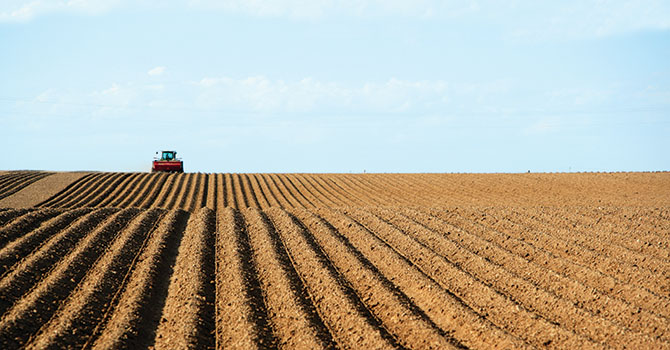Massive Footprints and Moderate Steps: Reducing the Greenhouse Toll of Food Production

Andrew Jones
Associate Professor of Nutritional Sciences
The health of our global food systems hangs in the balance of a changing climate. At the same time, these food networks also release a significant amount of carbon dioxide into the atmosphere, exacerbating our climate crisis.
Current climate trends place unprecedented pressures on global food systems. Warming temperatures threaten crop yields by reducing soil moisture and the uptake of nutrients by plants. The resulting deficiencies alter rates of plant development, which can reduce critical growth periods and increase susceptibility to pests and disease.1 Climate-related loss of biodiversity and declines in the nutrient content of certain grains and legumes under elevated CO2 concentrations in the atmosphere are concerns for maintaining a diverse food supply.2 Warmer water is also associated with declines in the productivity of fisheries around the globe.3
 Meanwhile, these vulnerable food systems themselves are responsible for more than
one-quarter of the greenhouse gas emissions generated by humans worldwide.4
Meanwhile, these vulnerable food systems themselves are responsible for more than
one-quarter of the greenhouse gas emissions generated by humans worldwide.4
Beyond the use of fossil fuels for powering tractors, manufacturing fertilizers, and transporting food, food systems contribute to emissions of methane—an even more potent greenhouse gas than CO2—through cultivation of rice in flooded paddies, decomposition of livestock manure (especially under confined conditions like feedlots), and dietary digestion by livestock such as cows, sheep, and goats. Agriculture, especially production of soy, palm oil, and cattle, accounts for as much as 80 percent of deforestation in tropical and subtropical countries.5 And the removal of forests—which serve as natural atmospheric carbon sinks—is a massive contributor to global greenhouse gas emissions.
Agricultural production remains the single largest contributor to greenhouse gas emissions in the food system and deserves ongoing scrutiny.
Anthropogenic greenhouse gas emissions have already warmed the planet by about one degree Celsius above pre-industrial levels. Without far-reaching global efforts to reduce emissions in the next decade, another half degree of warming seems likely. Though future warming cannot be fully prevented, many actions (including adjusting personal and business behaviors—see sidebar on next page), can prevent further escalation in temperatures and mitigate the worst impacts of climate change.
Nevertheless, agricultural production remains the single largest contributor to greenhouse gas emissions in the food system and deserves ongoing scrutiny. Soil cultivation, dietary digestion, biomass burning, rice production, manure management, and land-cover change are all part of how we produce food and are among the most potent contributors to greenhouse gas emissions.6
Approaches to reducing the carbon footprint of agriculture are hotly debated and vary from intensifying agricultural production to free up land for carbon storage to creating lower-input, multi-use agroecological landscapes. Less controversial—though still debated—is the outsize role of livestock production in contributing to emissions. Meat and dairy production account for about half of food-related greenhouse gas emissions and nearly one-fifth of global emissions.7 Demand for meat and milk has risen dramatically worldwide in recent decades and is expected to continue climbing through mid-century.
Even modest reductions in consumption of red meat in particular—chicken and fish have lower carbon footprints—can yield large reductions in food-related emissions.
Curbing consumption of these foods will be challenging, and meaningful change does not require mass conversions to veganism. Even modest reductions in consumption of red meat in particular—chicken and fish have lower carbon footprints—can yield large reductions in food-related emissions.8 Investments in alternative proteins like cell-cultured meat, plant-based meat alternatives like those produced by Impossible Foods and Beyond Meat, insects and algae, and blended meat-plant products (beef-mushroom blend burgers, for example) are promising interventions. Expanding the marketing of plant-rich dishes and changing government food policies are also important strategies.9 Animal-source foods remain a crucial component of healthy diets, especially for vulnerable populations in low-income contexts that lack access to nutritionally diverse foods.
The global food system must be transformed not only to meet the constraints of a changing global climate but to reduce its own contributions to this planet-wide situation. The unique interdisciplinary expertise and vision of public health researchers and practitioners will be an essential tool in catalyzing this transformation.
References
- Zhao, Chuang, et al., “Temperature Increase Reduces Global Yields of Major Crops in Four Independent Estimates,” Proceedings of the National Academy of Sciences 114/35 (August 2017): 9326-9331.
- Myers, Samuel S., et al., “Increasing CO2 Threatens Human Nutrition,” Nature 510 (June 2014): 139-42.
- Free, Christopher M., et al., “Impacts of Historical Warming on Marine Fisheries Production,” Science 363/6430 (March 2019): 979-983.
- Poore, J., and T. Nemecek, “Reducing Food’s Environmental Impacts through Producers and Consumers,” Science 360/6392 (June 2018): 987-992.
- Kissinger, Gabrielle, Martin Herold, and Veronique de Sy, Drivers of Deforestation and Forest Degradation: A Synthesis Report for REDD+ Policymakers (Vancouver: Lexeme, 2012).
- Vermeulen, Sonja J., Bruce M. Campbell, and John S. I. Ingram, “Climate Change and Food Systems,” Annual Review of Environment and Resources 37 (November 2012): 195-222.
- Garnett, Tara, “Livestock-Related Greenhouse Gas Emissions: Impacts and Options for Policymakers,” Environmental Science and Policy 12/4 (June 2009): 491-503.
- Aleksandrowicz, Lukasz, et al., “The Impacts of Dietary Change on Greenhouse Gas Emissions, Land Use, Water Use, and Health: A Systematic Review,” PLoS ONE 11 (November 2016): e0165797.
- Searchinger, Tim, Creating a Sustainable Food Future: A Menu of Solutions to Feed Nearly 10 Billion People by 2050 (World Resources Institute: Washington, 2018).
About the Author
 Andy Jones is associate professor of Nutritional Sciences at the University of Michigan
School of Public Health. His research examines relationships between food systems,
sustainability, and healthy diets. He currently leads projects in Ghana, Vietnam,
Kenya, and Peru examining how biodiversity within agricultural systems influences
healthy diets and how food value chains and food environments affect the diets and
health status of vulnerable communities. He is also researching how communities throughout
Michigan can transform their food systems to help mitigate climate change.
Andy Jones is associate professor of Nutritional Sciences at the University of Michigan
School of Public Health. His research examines relationships between food systems,
sustainability, and healthy diets. He currently leads projects in Ghana, Vietnam,
Kenya, and Peru examining how biodiversity within agricultural systems influences
healthy diets and how food value chains and food environments affect the diets and
health status of vulnerable communities. He is also researching how communities throughout
Michigan can transform their food systems to help mitigate climate change.
- Interested in public health? Learn more today.
- Read more articles about nutritional sciences.
- Support research at Michigan Public Health.
